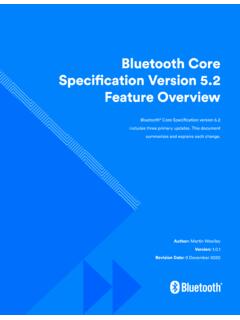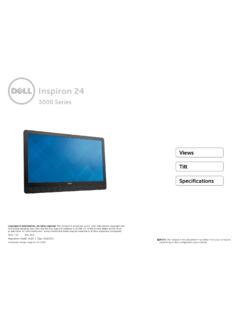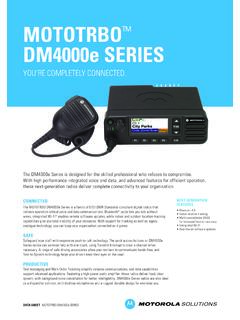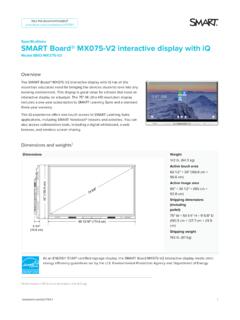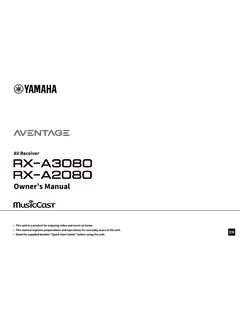Transcription of Introducing Bluetooth LE Audio
1 Introducing Bluetooth LE Audio A guide to the latest Bluetooth specifications and how they will change the way we design and use Audio and telephony products. by Nick Hunn First published January 2022. Paperback ISBN: 979-8-72-723725-0. Hardback ISBN: 979-8-78-846477-0. Copyright 2022 Nick Hunn All rights reserved. The Bluetooth word mark and logos are registered trademarks owned by Bluetooth SIG, Inc. and any use of such marks is with permission. Other trademarks and trade names are those of their respective owners. www | 2. Acknowledgements I would like to thank everyone who has helped towards the existence of this book. Without the work of many brilliant people contributing to the specifications, there would be nothing to write about. They are too numerous to list here, but they are recorded in each of the Bluetooth documents.
2 Trying to develop standards of this complexity results in many days and evenings of wide-ranging discussions, which have been both challenging and enjoyable. It has been a pleasure to work with so many people of passion who are always ready to spend time explaining the intricacies of wireless, Audio and its application. For taking the time to read through the drafts and coming back with detailed comments, I would particularly like to thank Richard Einhorn, Kanji Kerai, Ken Kolderup, Mahendra Tailor, Jonathan Tanner and Martin Woolley. Their input, from a variety of different reader angles, has helped make this into a much better book than it would otherwise have been. I must also thank the Bluetooth SIG for their help and support. For giving me permission to use the image of Figure , and also for playing a pivotal role in kickstarting the whole world of hearables, many thanks to Nikolaj Hviid of Bragi.
3 Finally, to my wife, Chris, for reading the endless drafts, as well as the final book from cover to cover multiple times, questioning everything, as well as putting up with the many hours I spent writing it. 3. 4. Contents Chapter 1. The background and heritage .. 11. The hearing aid 19. Limitations and proprietary extensions .. 20. What's in a hearable? .. 24. Chapter 2. The Bluetooth LE Audio architecture .. 29. The use cases .. 29. The Bluetooth LE Audio architecture .. 38. Talking about Bluetooth LE Audio .. 48. Chapter 3. New concepts in Bluetooth LE Audio .. 51. Multi-profile by 51. The Audio Sink led journey .. 51. Terminology .. 52. Context Types .. 56. Availability .. 60. Audio Location .. 60. Channel Allocation (multiplexing) .. 61. Call Control ID - CCID .. 63. Coordinated 64. Presentation Delay and serialisation of Audio 65.
4 Announcements .. 71. Remote controls (Commanders) .. 73. Chapter 4. Isochronous Streams .. 75. Bluetooth LE Audio topologies .. 75. Isochronous Streams and Roles .. 77. Connected Isochronous Streams .. 80. Broadcast Isochronous Streams .. 98. ISOAL The Isochronous Adaptation Layer .. 122. Chapter 5. LC3, latency and QoS .. 125. Introduction .. 125. Codecs and latency .. 126. 5. Classic Bluetooth codecs their strengths and 128. The LC3 codec .. 131. LC3 latency .. 137. Quality of Service (QoS).. 138. Audio quality .. 145. Multi-channel LC3 Audio .. 146. Additional codecs .. 151. Chapter 6. CAP and CSIPS .. 153. CSIPS the Coordinated Set Identification Profile and Service .. 153. CAP the Common Audio Profile .. 156. Chapter 7. Setting up Unicast Audio Streams .. 163. PACS the Published Audio Capabilities Service.
5 163. ASCS the Audio Stream Control Service .. 174. BAP the Basic Audio Profile .. 179. Configuring an ASE and a CIG .. 182. Handling missing Acceptors .. 198. Preconfiguring CISes .. 198. Who's in charge? .. 199. Chapter 8. Setting up and using Broadcast Audio Streams .. 201. Setting up a Broadcast Source .. 202. Starting a broadcast Audio 203. Receiving broadcast Audio Streams .. 211. The broadcast reception user experience .. 213. BASS the Broadcast Audio Scan 213. Commanders .. 214. Broadcast_Codes .. 222. Receiving Broadcast Audio Streams (with a Commander) .. 223. Handovers between Broadcast and Unicast .. 228. Presentation Delay setting values for 229. Chapter 9. Telephony and Media Control .. 231. Terminology and Generic TBS and MCS 232. Control topologies .. 234. 6. TBS and CCP.
6 235. MCS and MCP .. 242. Chapter 10. Volume, Audio Input and Microphone Control .. 251. Volume and input control .. 251. Volume Control Service .. 253. Volume Offset Control 256. Audio Input Control Service .. 257. Putting the volume controls 261. Microphone control .. 262. A codicil on terminology .. 264. Chapter 11. Top level Bluetooth LE Audio profiles .. 267. HAPS the Hearing Access Profile and Service .. 268. TMAP The Telephony and Media Audio Profile .. 271. Public Broadcast Profile .. 274. Chapter 12. Bluetooth LE Audio applications .. 277. Changing the way we acquire and consume Audio .. 278. Broadcast for all .. 279. TVs and 285. Phones and broadcast .. 288. Audio 289. Personal communication .. 290. Market development and notes for developers .. 292. Chapter 13. Glossary and concordances.
7 295. Abbreviations and initialisms .. 295. Bluetooth LE Audio specifications .. 299. Procedures in Bluetooth LE Audio .. 300. Bluetooth LE Audio characteristics .. 304. Bluetooth LE Audio terms .. 306. 7. 8. Introduction Back in the spring of 2013, I remember sitting in a conference room in Trondheim with representatives of the hearing aid industry as they explained to the Bluetooth Board of Directors why they should commit time and effort to develop a Bluetooth Low Energy specification that would support the streaming of Audio . I'd been asked by the hearing aid companies if I would chair the working group to develop the new specifications. Everyone agreed it was a good idea and the two groups the Bluetooth Special Interest Group (SIG), and EHIMA the Hearing Instrument Manufacturer's Association the trade body representing the industry, signed a Memorandum of Understanding to start work on a new specification to support Audio over Bluetooth Low Energy.
8 At the time, we all thought it would be a fairly quick development hearing aids didn't need enormously high Audio quality their main concern in terms of Bluetooth technology was to minimise power consumption. What none of us had realised at the time was that the technology and use cases that had been developed by the hearing aid industry were quite a long way ahead of what the consumer Audio market was currently doing. Although the long- established telecoil system of inductive loops, which allowed broadcast Audio to reach multiple hearing aids only provided limited quality Audio , the connection topologies they supported were more complex than those provided by the existing Bluetooth A2DP and HFP Audio profiles. In addition, the power management techniques and optimisations used in hearing aids gave battery lives that were an order of magnitude greater than those in similarly sized consumer products.
9 Over the next twelve months, as we developed functional requirements documents, more and more of the traditional Audio and silicon companies came to look at what we were doing, and decided that many of the features that we were proposing for hearing aids were equally applicable to their markets. In fact, they appeared to solve many of the limitations that existed in the current Bluetooth Audio specifications. As a result, the requirements list grew and the small hearing aid project evolved into the largest single specification development that the Bluetooth SIG has ever done, culminating in what is now collectively known as Bluetooth LE. Audio . It's hard to believe that the journey has taken eight years. At the end of it we have produced two major revisions to the Core specification, introduced a completely new, high efficiency codec and released twenty-three profile and service specifications, along with accompanying documentation and Assigned Numbers documents, which between them contain around 1,250 new pages.
10 For anyone not involved with that eight-year journey, it's a pretty formidable set of documents to start reading. The purpose of this book is to try and put those specifications into context, adding some of the history and rationale behind them, to help readers understand how the different parts interconnect. I've also provided some background information on the market 9. and what's in a hearable, to help readers relate the specification to actual products. In the chapters which delve into detail, I've included references to the specific part of the specifications using their abbreviated name and section number, [BAP ] for Section of the Basic Audio Profile. I've tried to limit the number of references, so that they don't get in the way of the text. The glossaries and concordances in Chapter 13 should also help developers navigate their way around the documents.
